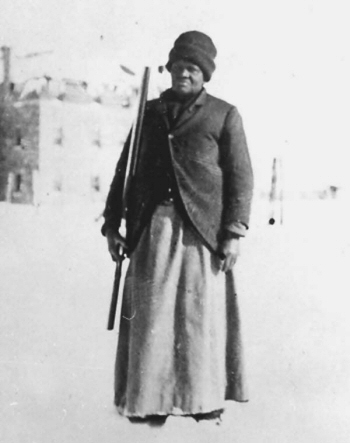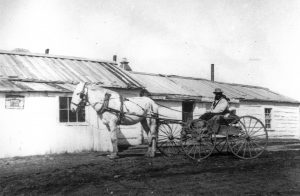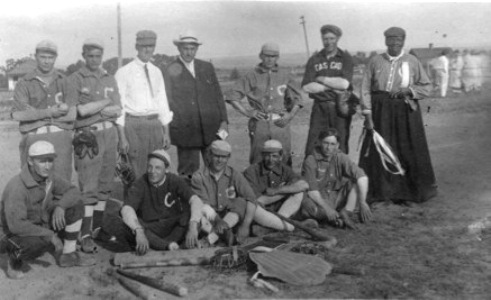Stagecoach Mary Fields – Wild West Badass and First Black Woman to Carry the Mail
 Born a slave in Hickman County, Tennessee around 1832, “Stagecoach” Mary Fields, also known as Black Mary, was a formidable figure in the Old West. She stood 6 feet tall and weighed about 200 lbs. She loved to smoke cigars, usually had a pistol strapped under her apron and a jug of whiskey by her side.
Born a slave in Hickman County, Tennessee around 1832, “Stagecoach” Mary Fields, also known as Black Mary, was a formidable figure in the Old West. She stood 6 feet tall and weighed about 200 lbs. She loved to smoke cigars, usually had a pistol strapped under her apron and a jug of whiskey by her side.
As a young girl Mary outgrew most of the boys her age and by 18-years-old she struck an imposing figure at 6ft and over 200 pounds. Details of Mary’s early life are scarce, but at some point, she formed a lifelong friendship with Sarah Teresa Dunn, a relative of her master Edmund Dunn.
In 1865, with the passing go the 13th Amendment and the abolishment of slavery, 33-year-old Mary became a free woman. For a number of years, she found employment aboard the steamboat Robert E Lee, until she fortuitously bumped into her former master who informed her that her old friend Sara had joined a convent in Toledo, Oh. Without hesitation, Mary packed up her belongings and traveled north to join her friend.
For around the next 15 years, she dedicated herself to her work at the convent for which she received room, meals, and fifty dollars a year. In 1884 Sarah Dunn, by then known as Mother Amadeus, was sent to Montana territory to establish a school for Native American girls. A year later, upon learning her friend was very ill, a 52-year-old Mary braved a colossal 1600 mile journey alone to nurse her back to health.
 Arriving in Cascade in 1885, she was the first Black woman to ever set foot in the small town. After nursing Mother Amadeus back to health, she spent the next 8 years building the mission a convent, 2 stone buildings, and a church. Refusing the assistance of men, Mary would carry immensely heavy loads of lumber and stone on her back. When construction the mission was complete, Mary settled there with the sisters and began hauling freight on a stagecoach for a living.
Arriving in Cascade in 1885, she was the first Black woman to ever set foot in the small town. After nursing Mother Amadeus back to health, she spent the next 8 years building the mission a convent, 2 stone buildings, and a church. Refusing the assistance of men, Mary would carry immensely heavy loads of lumber and stone on her back. When construction the mission was complete, Mary settled there with the sisters and began hauling freight on a stagecoach for a living.
During her time in Cascade, Mary earned herself a striking reputation. As an ex-slave and a woman who drank whiskey, swore, and carried a six-shooter pistol, Mary was something of an enigma to the locals. Men often learned to respect her the hard way.
One man who offended her was pelted with rocks until he cried. Another who challenged her to a duel was shot so close to his head that he immediately conceded and never spoke to her again. The Great Falls Examiner reported that Mary broke more noses than any other person in central Montana. This unladylike behavior caught the attention of the mission’s Bishop who exiled Mary from the convent she had single-handedly built.
After leaving the mission, Mary briefly opened a restaurant but her generous nature of serving food whether people could pay or not led to it being forced to close. Upon hearing of her friend’s financial difficulty, Mother Amadeus secured Mary a position as a US Postal Service carrier. Delivering mail in the Wild West carried immense dangers and involved long arduous horseback journeys through hostile territories. A successful delivery was valued more than the life of the carrier. A popular saying among postal service workers of the time was that the horse and rider should perish before the mail.
Out of all the applicants for the job, Mary (a woman in her sixties), hitched a team of six horses faster than men half her age. Upon her hiring, she became the second female and first Black female mail carrier in the history of the western United States.
Her route was a 19-mile stagecoach journey between Cascade and St. Peter’s mission. Allowing her to return daily to the place she was exiled from. Stagecoach Mary never missed a day of work and when the snow was too deep for horses she would strap the mail bags to her back and deliver them on foot.
In her 10 years of service, she went from an outcast to one of Cascade’s most respected citizens. In her early 70s, Mary retired from the Postal Service and settled in Cascade. She opened a small laundry business that was devastated by a fire. The residents of Cascade, remembering the generosity of her restaurant days, rushed to her aid. Donating whatever they could, from shelter to food and clothing.
 When Montana passed a law forbidding women from entering drinking establishments, the Mayor of Cascade gave Mary special permission to drink in the saloon where would spend hours discussing politics and sports. She particularly enjoyed baseball and was invited by the Cascade baseball team to travel the state with them. Attending all their games as their guest of honor.
When Montana passed a law forbidding women from entering drinking establishments, the Mayor of Cascade gave Mary special permission to drink in the saloon where would spend hours discussing politics and sports. She particularly enjoyed baseball and was invited by the Cascade baseball team to travel the state with them. Attending all their games as their guest of honor.
Not knowing her true date of birth Mary chose to observe a birthday twice a year – whenever she felt like it. On those days the schools of Cascade were closed for the celebrations. Mary died on December 5, 1914, of a severe case of Edema. After her death, both local papers published her obituary on the front page and her funeral was the largest in the town’s history. Until her death and for almost 40 years after, she was the only Black person to have ever resided in the town of Cascade. She was laid to rest along her old postal route just outside of St. Peter’s Mission.
Mary was a quintessential example of the large roles of Blacks and women on the frontier. Not only did she overcome the challenges of asserting herself in a male-dominated world, she also defied racial prejudice and became a valued and beloved member of her community.